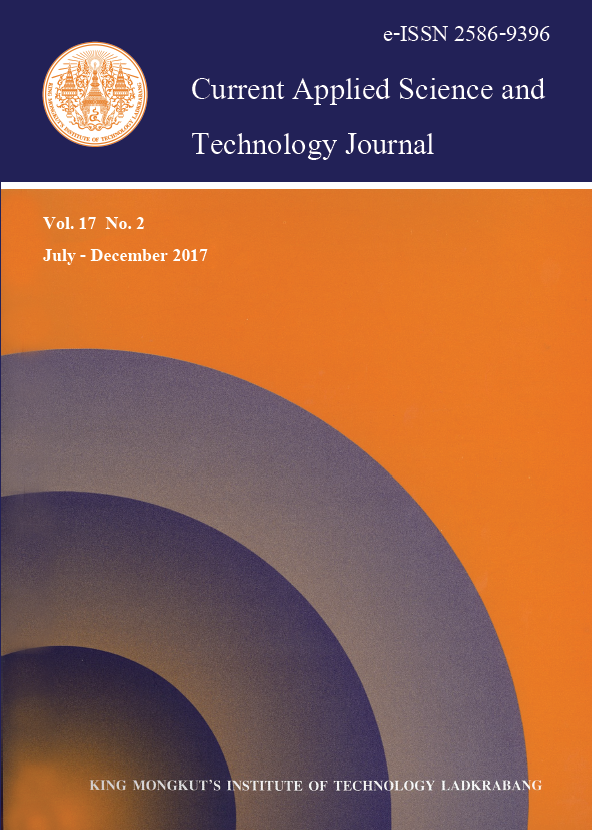Size-concentration Dependent Analysis of Nanoparticle Agglomeration in Aqueous Suspension
Main Article Content
Abstract
A direct simulation Monte Carlo (DSMC) model is applied for the analysis of TiO2 nanoparticles (TNP) agglomeration at various initial mass concentrations in an aqueous suspension. In this approach, TNP is simulated in a box. The agglomeration probability of NP is simulated within the context of Brownian motion. At diluted concentrations, model prediction is in quantitative agreement with the particle size distribution via dynamic light scattering measurement. This study shows that the applied DSMC model has the potential to predict the TNP size distribution in aqueous environment at the short time scale.
Keywords: DSMC, nanoparticles, agglomeration, Monte-Carlo, size-distribution
*Corresponding author:
Email: yaowapa.ac@gmail.com
Article Details
Copyright Transfer Statement
The copyright of this article is transferred to Current Applied Science and Technology journal with effect if and when the article is accepted for publication. The copyright transfer covers the exclusive right to reproduce and distribute the article, including reprints, translations, photographic reproductions, electronic form (offline, online) or any other reproductions of similar nature.
The author warrants that this contribution is original and that he/she has full power to make this grant. The author signs for and accepts responsibility for releasing this material on behalf of any and all co-authors.
Here is the link for download: Copyright transfer form.pdf
References
[2] Chen, X., Mao, S.S., 2007. Titanium dioxide nanomaterials: synthesis, properties, modifications, and applications. Chemical Reviews, 107(7), 2891-2959.
[3] Mu, L., Sprando, R.L., 2010. Application of nanotechnology in cosmetics. Pharmaceutical research, 27(8), 1746-1749.
[4] Nakata, K., Fujishima, A., 2012. TiO2 photocatalysis: design and applications. Journal of Photochemistry and Photobiology C: Photochemistry Reviews, 13(3), 169-189.
[5] Suttiponparnit, K., Jiang, J., Sahu, M., Suvachittanont, S., Charinpanitkul, T., Biswas, P., 2010. Role of surface area, primary particle size, and crystal phase on titanium dioxide nanoparticle dispersion properties. Nanoscale Res Lett, 6(1), 27.
[6] Ji, Z., Jin, X., George, S., Xia, T., Meng, H., Wang, X., Suarez, E., Zhang, H., Hoek, E.M.V., Godwin, H., Nel, A.E., Zink, J.I., 2010. Dispersion and Stability Optimization of TiO2 Nanoparticles in Cell Culture Media. Environmental Science & Technology, 44(19), 7309-7314.
[7] Jiang, J., Oberdörster, G., Biswas, P., 2009. Characterization of size, surface charge, and agglomeration state of nanoparticle dispersions for toxicological studies. Journal of Nanoparticle Research, 11(1), 77-89.
[8] Chae, S.Y., Park, M.K., Lee, S.K., Kim, T.Y., Kim, S.K., Lee, W.I., 2003. Preparation of size-controlled TiO2 nanoparticles and derivation of optically transparent photocatalytic films. Chemistry of Materials, 15(17), 3326-3331.
[9] Liu, H.H., Surawanvijit, S., Rallo, R., Orkoulas, G., Cohen, Y., 2011. Analysis of nanoparticle agglomeration in aqueous suspensions via constant-number monte carlo simulation. Environmental Science & Technology, 45(21), 9284-9292.
[10] Liu, H.H., Lanphere, J., Walker, S., Cohen, Y., 2015. Effect of hydration repulsion on nanoparticle agglomeration evaluated via a constant number Monte–Carlo simulation. Nanotechnology, 26(4), 045708.
[11] Kruis, F.E., Maisels, A., Fissan, H., 2000. Direct simulation Monte Carlo method for particle coagulation and aggregation. AIChE Journal, 46(9), 1735-1742.
[12] Bird, G.A., 1976. Molecular gas dynamics. Sydney, Australia: Clarendon Press.
[13] Smoluchowski, M.v., 1918. Versuch einer mathematischen Theorie der Koagulationskinetik kolloider Lösungen. Zeitschrift fur Physikalische Chemie, 92(1), 129-168.
[14] Baalousha, M., 2009. Aggregation and disaggregation of iron oxide nanoparticles: Influence of particle concentration, pH and natural organic matter. Science of the Total Environment, 407(6), 2093-2101.
[15] Kato, H., Fujita, K., Horie, M., Suzuki, M., Nakamura, A., Endoh, S., Yoshida, Y., Iwahashi, H., Takahashi, K., Kinugasa, S., 2010. Dispersion characteristics of various metal oxide secondary nanoparticles in culture medium for in vitro toxicology assessment. Toxicology In Vitro, 24(3), 1009-1018.
[16] Zhang, Y., Chen, Y., Westerhoff, P., Hristovski, K., Crittenden, J.C., 2008. Stability of commercial metal oxide nanoparticles in water. Water Research, 42(8), 2204-2212.
[17] Guzman, K.A.D., Finnegan, M.P., Banfield, J.F., 2006. Influence of surface potential on aggregation and transport of titania nanoparticles. Environmental Science & Technology, 40(24), 7688-7693.


